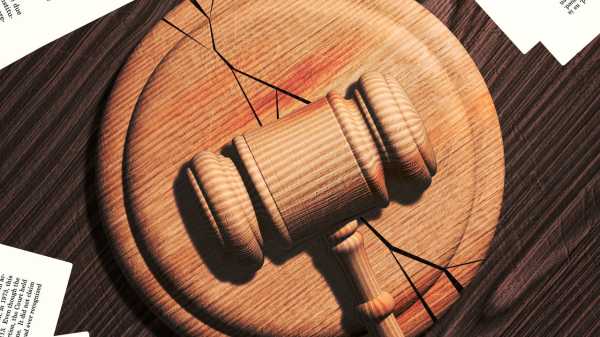
This was a year that was split into before and after—the dividing line being when the Supreme Court overruled Roe v. Wade. Following the shocking leak of the draft opinion in Dobbs v. Jackson Women’s Health Organization, on May 2nd, we fully entered the era of conservative dominance, with aggressive rulings on abortion, guns, and religion. Doubts about the Court’s legitimacy reached a fever pitch, and its unpopularity hit alarming lows. Soul-searching about the Court and the rule of law has rarely been as cynical or as fundamental. Law professors asked one another, “What do we say to students now?,” with many questioning the distinction between law and politics, or even the Court’s final authority to interpret the Constitution—which the Court first claimed for itself about two hundred years ago. The Justices appeared to understand that they are presiding over a historic decline in public trust, as several of them have made public remarks insisting on the importance of the Court’s retaining its legitimacy. “Everybody in this country is free to disagree with our decisions,” Justice Samuel Alito, who wrote the Dobbs majority opinion, said. But he warned that someone “crosses an important line when they say that the Court is acting in a way that is illegitimate.”
2022 in Review
New Yorker writers reflect on the year’s highs and lows.

When the Court returned for its new term in the fall, the Justices dove into another set of blockbuster cases, on affirmative action, voting rights, and religious liberty. But cracks have emerged in the commitment to originalism that conservatives wielded last term to tie the meaning of the Constitution to “history and traditions” from periods when women couldn’t vote and segregation was the law. Liberal Justices made us wonder whether we’re all supposed to be originalists now—or strategically pretend to be. Take, for example, this term’s debates about the meaning of the Fourteenth Amendment. In a case asking whether Alabama created enough majority-Black electoral districts to comply with the Voting Rights Act, and whether the use of race in districting violates the Fourteenth Amendment, Justice Ketanji Brown Jackson refused to cede originalism to conservatives, instead describing it as “our normal assessment of the Constitution.” Professing to have “drilled down” and looked at “the history and traditions of the Constitution, at what the Framers thought about,” Jackson, in one of her first hearings as a Justice, lectured counsel extensively on how the original meaning of equal protection was not race-neutral, since “the Framers themselves adopted the equal-protection clause . . . in a race-conscious way.” (Jackson explained that “the entire point of the amendment was to secure rights of the freed former slaves”—which is clearly correct but likely to be ignored by conservative originalists.) Similarly, at oral arguments in the cases on affirmative action in college admissions, Justice Elena Kagan asked, “What would a committed originalist think about the kind of race-consciousness that’s at issue here?”—knowing that a “committed originalist” would reject the view that her conservative colleagues will likely adopt this term, that racial classifications are wrong. The debate—or, perhaps, liberal judicial trolling—highlighted the Justices’ waxing and waning adherence to originalism, depending on whether it produces the desired result in a given case. That only confirmed the sense of a crisis of legitimacy.
A pro-religion view of the First Amendment has been on the march this year. A series of significant victories for religious plaintiffs included the Court’s decisions that a high-school football coach must be permitted to kneel and pray on the field after games, that Maine must pay tuition for students living in districts lacking public schools and choosing to attend religious schools, and that Boston must allow a Christian flag to be flown on a flagpole outside city hall if it allows nonreligious flags. This term, the Court heard a free-speech case in which a Colorado Web designer seeks the Court’s approval to refuse to provide services for same-sex weddings, despite a state law prohibiting discrimination against L.G.B.T. people. The Court appears likely to decide that the First Amendment prevents a state anti-discrimination law from requiring people to provide services for same-sex weddings, if the service is artistic, such as designing Web sites. Perhaps the ruling will be limited to sensitivities about marriage rather than the status of being gay. But the case is part of the steady pursuit of a maximalist vision of the First Amendment in which conflicts between religion and other values are resolved in favor of religion, and religious people and institutions can be exempt from legal strictures that bind everyone else.
No constitutional case this term involves an argument as implausible and as consequential as Moore v. Harper, in which North Carolina legislators claim that the Constitution prohibits state courts from reviewing state legislatures’ decisions on how to conduct federal elections. The state’s highest court threw out the Republican state legislature’s gerrymandered congressional-district maps because they violated state constitutional guarantees of, among other things, free elections and equal protection. The state legislators argue that the state court lacked authority to do that because the Constitution’s elections clause says that the time, place, and manner of holding federal elections for senators and representatives “shall be prescribed in each State by the Legislature thereof.” The consequence of this theory would be that state legislatures could engage in gerrymandering or voter suppression in federal elections without limits by state courts. Without those checks, the tendency of the majority party to draw maps that keep it in power would soon destroy any semblance of democracy. The oral argument revealed skepticism from enough Justices, including John Roberts, Brett Kavanaugh, and Amy Coney Barrett, that one can plausibly hope that at least five or six of them will have the good sense to reject the fantasy of a legislature unbounded by the judiciary. Particularly in a time when the Court faces attacks on its authority, the Justices might well find it unappealing to undermine judicial review, even in the context of state judiciaries.
Criticism of the Court this year has featured not merely disagreements with its decisions but also suspicions of ethical lapses. Last month, the Times published the allegation that Justice Alito, who had called the Dobbs leak a “grave betrayal,” had himself leaked the outcome of the Hobby Lobby decision to pro-life-activist friends, in 2014. (Alito has denied disclosing the decision.) The Times’ source, a former anti-abortion activist, also sent a letter this past summer to the Chief Justice alleging this prior leak, which he said went unacknowledged. The sense that the Court may be struggling or helpless to enforce ethical norms, underlined by the Dobbs leak, has only grown since then. In May, the Chief Justice announced an investigation of the Dobbs leak, but that has been followed by eight months of radio silence on the matter.
A constitutionally available check on the Court is impeachment of a Justice (which has occurred once, in 1804), and, this year, calls for impeachment became louder than in recent memory, particularly regarding Justice Clarence Thomas. He was the lone public dissenter in the Court’s decision that allowed the release of records by the National Archives to the January 6th committee, and, when messages written by his wife, Ginni Thomas, in her efforts to overturn the 2020 Presidential election, surfaced, many Democrats became disturbed that he had not recused himself. In a less polarized time, in which Justices were assumed to keep themselves above the fray, it would be easier for the public to accept Ginni’s word that she generally does not discuss her political activities with her husband, suggesting that he had no knowledge that would give him reason to recuse himself. But, in 2022, Justices had to openly defend themselves as not merely “a bunch of partisan hacks,” as Barrett put it in a speech this fall, or “junior varsity politicians,” as Stephen Breyer said in a lecture shortly before his retirement.
The Court’s defensiveness about its authority came into view most directly at an oral argument in an immigration case, which challenged the legality of the Biden Administration’s policy of prioritizing the arrest and deportation of people who are suspected of terrorism or other serious crimes, or were apprehended at the border. A Texas federal court determined that the policy was unlawful and vacated it, and the Administration took the sweeping position that courts, under the Administrative Procedure Act, cannot vacate agency rules or regulations that they may find unlawful. The Chief Justice did not hide his outrage at the argument. “Wow,” he exclaimed, calling it “radical.” An even more scandalized Kavanaugh scolded the Solicitor General, saying that “I find it pretty astonishing that you come up here” and make this argument which would “just toss out decades of this Court’s law.” (It was ironic, after Dobbs, to hear this level of alarm from Kavanaugh at the idea of tossing out decades of precedent.) Jackson and Barrett, too, followed in resisting the idea. The anxiety was palpable at the claim, made calmly by the U.S. government to the Justices in open court, that their power was far more limited than the Court had assumed for decades. But the argument bore some resemblance to what the Court had suggested it was undertaking in Dobbs, in which it took away its own power to invalidate abortion regulations, leaving the issue to the political branches and the states. The exchange announced that this is indeed a new era, one not only of judicial conservatism but also of open challenges to the Court’s authority. The response was tantamount to “How dare you?” The people do dare, and the coming year may see more normalization of such efforts inside and outside the courtroom. ♦
Sourse: newyorker.com